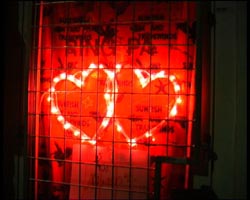| Cecilie
Høgsbro on the artist Nanna Buhl: |
| From place
to space |
| Nanna Buhl's
video project, "Red light transition", is a visual
essay more than a classic documentary. One central aim is to
investigate how our concept of public space has changed as different
practices, formerly related to and defining concrete urban space,
have moved into the virtual sphere of the media. This development
is not due to the new technologies alone, but also to the growing
homogeneization and hygienization of the urban enviroment, caused
by commercial and political interests in creating "sound"
urban environments. To exemplify and analyze this situation Buhl
has chosen to study prostitution in the Copenhagen red light
district and the profound changes it has undergone during the
last ten years. |
 pict1, pict 2,
pict 4 pict1, pict 2,
pict 4 |
| Images of prostitution |
| While prostitution
is called women's oldest labor, the invention of pornography
- visualized, commercialized and distributable sex - is said
to be one of the mere signs of modernity. Considering itself
a modern state Denmark was the first country to legalize porn
in 1969. The liberal attitude towards pornography played a very
important role in the cultural campaign of the welfare state
against any kind of societal hippocracy, whether sexual, religious
or political, which could possibly degenerate the individual.
That pornography in itself was based on quite suppressive, even
morbid stereotypes wasn't a political, moral or logical issue
at the time. |
| |
| Though pornography,
due to legislation and media technology, became more and more
visible within the public space, public prostitution continued
being illegal. If free pornography was considered almost healthy,
not at least to the GNP, street prostitution remained "unhealthy",
causing moral offense, crime, repression and disease and was
therefore permanently combated. Prostitution therefore got increasingly
pornografized - and in a way legalized - by using the media and
the media language instead of the street for advertising. |
| |
| The "liberation"
of pornography was thus a clear symptom of the complex alteration
in the spatial organisation of Western democracies, especially
after the 1950's Sexual behaviour used to be spatialized in a
certain way, that even defined the limits between private and
public domaines. As we know, the private sphere had been synonymous
with domesticated, tamed feminity for many years. It was acknowledged
that the stability of the private household rested on the existence
of prostitutes; domesticated middle-class feminity was secured
through constant contrast with the perils of unregulated female
sexuality in the street, the so called public women. |
| |
| As women were
moving out of the traditional private sphere, non-reproductive,
commercial sex - pornography - was moving in and was potentially
sexualizing the home in new ways. Legalized pornography thus
illustrated that the virtues of private space couldn't be stabilized
by the public sphere anymore. Porn had created a transgressive
sphere of its own, that didn't distinguish between private and
public sex or space, but was distributed all over the place.
In other words pornography has been one crucial example of how
mass phenomena during the last 50 years have been creating new
spaces, within the existing spheres, which can't be defined as
neither pure public nor pure private but need new definitions
in order to be understood. |
| |
| Cecilie Høgsbro |
| |
|
top |
 pict1, pict 2,
pict 4
pict1, pict 2,
pict 4